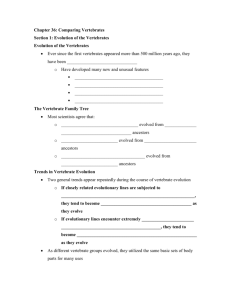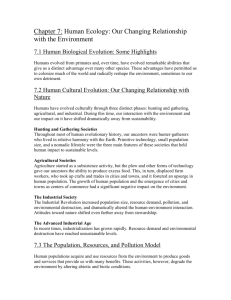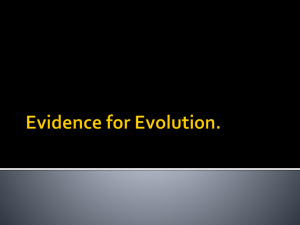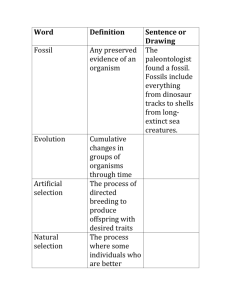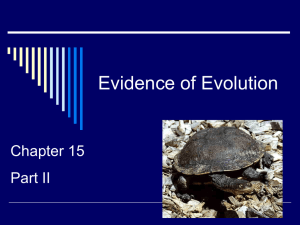Evidence
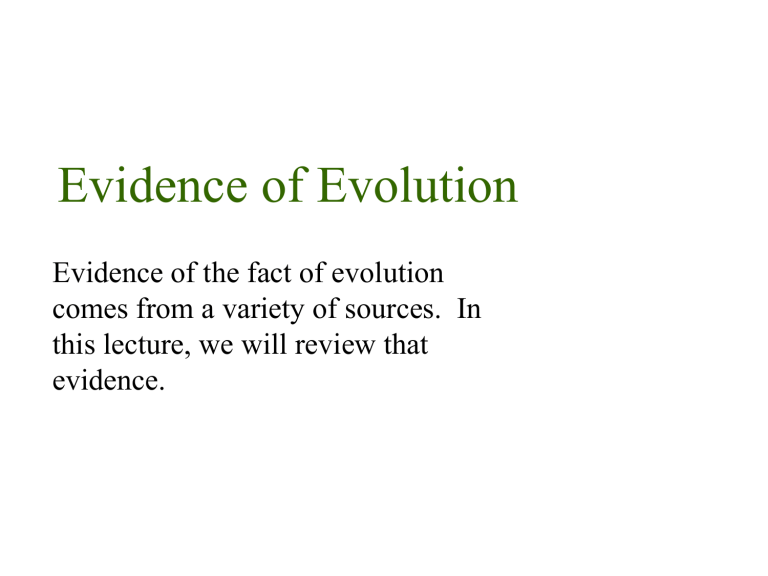
Evidence of Evolution
Evidence of the fact of evolution comes from a variety of sources. In this lecture, we will review that evidence.
We can identify three theories to consider:
Evolution
Transformism
Special Creation
We can actually observe evolution in action, in small scale.
House sparrow
Passer domesticus
We can also create evolution artificially.
We can demonstrate selection in rats resistance to cavities
But none of these examples show the formation of new species. How can we show that?
First, must decide what we mean by species.
Hierarchy of the Linnaean system of taxonomy
Kingdom
Phylum
Class
Family
Order
Genus species
We employ two different species concepts:
Biological Species Concept
– Based on interbreeding
Morphological Species Concept
– Based on phenotypic similarity
One of the best examples showing that evolution can result in speciation are the existence of ring species.
One example can be seen in salamanders of the genus Ensatina
Greenish warbler – Phylloscopus trochiloides
Herring gull – Larus occidentalis
A molecular homology
The suppression of the amber mutation in bacteria suggests that the genetic code is chemically alterable. This implies that it is not chemically restrained.
Plant speciation can occur through the formation of polyploid hybrids. It has been estimated that roughly 50% of flowering plant species originated as polyploid hybrids.
Primula kewensis
The first artificially created hybrid polyploid species.
Plant Hybrids
Fossil Record
Using fossils, we can trace the history of life on earth back over a period of several billion years. We note that older life forms are simpler than more modern forms. We also note the transition of ancestral forms into the forms we see today.
The appearance of organisms in the fossil record is ordered, rather than random.
The logical deduction is that the sequential appearance results from evolution.
FIGURE 6.1 Paleontology
Appearance of animals and plants, early (bottom) to recent (top). Random (left) appearance of organisms-humans, some plants, more mammals, fishes, microorganisms, birds. Ordered (right) appearance from singlecelled, to multicelled, to fishes, amphibians, reptiles, birds, and mammals, including humans.
In addition, the appearance of organisms in the fossil record corresponds to their morphological similarities.
In other words, we see the same pattern of development in the fossil record that we see in morphology.
FIGURE 6.5 Morphological Series
From four-toed to single-toed modern horses, this morphological series illustrates the correspondence between parts (feet, teeth, skull) and their modifications. Here, the stratigraphic position of these species is added.
Evolution of horses
Evolution of horses
The similar designs of vertebrate forelimbs reflects their common ancestry.
Comparative anatomy
Correspondence between parts and comparison of forelimbs among four vertebrates.
Although the forelimb in all is used differently—human (grasping), bird (flight), lion
(running), seal (swimming)—all have the same basic underlying structure of bones and soft tissues.
Homology and analogy
(a) Homology. As vertebrate forearms, the bat wing, mouse forearm, and human arm are homologous structures as all are composed of similar bones inherited from a recent common ancestor. (b) Analogy. The wings of bats, butterflies, and birds evolved independently, not from a recent common ancestor. But they have a similar function, flight, and so are analogous.
FIGURE 6.3 Different Functions but Similar Underlying Forelimb
Anatomy
Forelimbs of bat, mole, and dugong. Each limb performs a different function-flight, digging, and swimming, respectively-and all are superficially different, but all three share a common, underlying anatomical plan.
In contrast, designed structures do not show a similar correspondence of parts.
By human design
Functions vary and designs vary. Unlike biological organisms, these humanly designed and built machines show no correspondence of parts from planes (flight), to mining machines
(burrowing), or to boats (swimming).
Morphological series—evolution of limbs from fins
Note that the bones of the fish hip and shoulder correspond to bones in this early tetrapod
(amphibian). Here, the morphological series carries from one type of vertebrate (fish) to another (amphibian), and from one environment (water) to another (land).
Morphological series—evolution of jaws
Vertebrate jaws evolved from the front set of gill arches of jawless ancestors.
Diversity of type, unity of pattern
Although the vertebrate species differ, the underlying pattern of the forelimb is fundamentally the same.
FIGURE 6.7 Diversity of Type, Unity of Pattern
(a) Similarities. Parts may be similar in ancestry, function, and/or appearance.
Respectively, these are defined as homology, analogy, or homoplasy. (b) Although the vertebrate species differ, the underlying pattern of the forelimb is fundamentally the same.
FIGURE 6.8 Convergence of Design
Groups of animals often adapt to habitats that differ from those of most other members of their group. Most birds fly, but some, such as ostriches, cannot, and live exclusively on land; others, such as penguins, live much of their lives in water. Most mammals are terrestrial, but some fly (bats) and others live exclusively in water (whales, dolphins). “Flying” fishes take to the air. As species from different groups enter similar habitats, they experience similar biological demands. Convergence to similar habitats, in part, accounts for the sleek bodies and fins or flippers of tuna and dolphins, because similar functions (analogy) are served by similar parts under similar conditions. Yet tuna and dolphins come from different ancestries and are still fishes and mammals, respectively. Common function alone is insufficient to explain all aspects of design. Despite current similar habitats, each design carries evolutionary features of the past into the present.
Comparative Embryology
If we examine development stages from organisms of different species, we see that similarities are retained.
These shared “templates” reflect the historical continuity between the organisms.
Embryonic retention of ancestral characteristics. Note the persistence of gill slits in early stages of embryonic development in the mammals (right) that of course, do not possess functional gills in the adult. Also note that a tail is present early in humans, but lost before birth.
Vestigial or Atavistic Structures
Vestigial structures are rudimentary structures, typically no longer functional, that are left over from a time when they played a prominent role.
Atavistic structures represent the return of ancestral features.
Vestigial features I a) Whales evolved from terrestrial ancestors with four legs. But in whales, the hips and hindlimbs are reduced to small bones with no function. b) Snakes evolved from lizards with four legs. But in primitive snakes, the remnants of hindlimbs persist (forelimbs are absent).
Vestigial features II
The human appendix is a vestigial structure, reduced from the cecum of primate ancestors, where it was involved in digestion of significant amounts of plant material. Shown here is the human stomach leading into parts of the small intestine (duodenum, jejunum, ileum), which empties into the large intestine (ascending colon). Note the appendix at this juncture.
FIGURE 6.10 Vestigial Features
(a) Whales evolved from terrestrial ancestors with four legs. But in whales, the hips and hindlimbs are reduced to small bones with no function. (b) Snakes evolved from lizards with four legs. But in primitive snakes, the remnants of hindlimbs persist (forelimbs are absent). (c) The human appendix is a vestigial structure, reduced from the cecum of primate ancestors, which was involved in digestion of significant plant material.
FIGURE 6.11 Atavistic Features
Extra toes in modern horses. (a) Modern horses have only one enlarged digit on each foot, a single toe. The one toe evolved from ancestors with three or four toes. During the course of their evolution, the peripheral toes—IV, II, I— were lost and the central toe—III—emphasized. (b,c) On rare occasions, however, these “lost” toes or their remnants reappear, testifying to the lingering presence of the underlying ancestral developmental pattern. (d) On rare occasion, a modern horse, such as the one illustrated, is born with additional toes. Such toe remnants in modern horses apparently represent the partial reemergence of an ancient ancestral pattern. For more information on extra toes in modern horses, see S. J. Gould, Hen’s Teeth and Horse’s Toes: Further Reflections in Natural
History (New York: W. W. Norton, 1983).
Dinosaur distribution
During the middle of the Mesozoic era, the dinosaur Allosaurus occupied the large, single continent of Pangaea (see also “Continental drift”). Subsequently, as this continent broke apart, populations of Allosaurus became isolated from each other and speciated into other derivative carnivorous species (Gigantotosaurus, Carcharodontosaurus, Acrocanthosaurus).
The forming continents drifted into their present positions today. The location of these fossil remains, now carried into distant locations, are indicated by dots.
Distributional Evidence
Organisms are not distributed uniformly, or randomly, across the surface of the planet.
If species have evolved, we would expect their geographic patterns of distribution to reflect this evolutionary history.
They do.
FIGURE 6.12 Biogeographic Realms
Continental land areas support characteristic assortments of plants and animals, which in turn define six biogeographic realms. The number of mammalian families are indicated, along with the number of endemic families.
FIGURE 6.13a Continental Drift
(a) Plate tectonics. Shown are the suture zones of abutting major current crustal plates and their respective movement directions.
Continental drift
Changing continental positions through most of the Phanerozoic era. Time, in millions of years, is approximate.
FIGURE 6.14 Bridges
Connections between geographic areas allow for or restrict dispersal of plants and animals. (a) Corridors and filter bridges. Corridors allow for the relatively uninterrupted spread of organisms. The doubleheaded arrows indicate such open expanses across Eurasia and North America. Filter bridges permit selective transit of organisms that pass, either because of inhospitable climate or ecological obstruction. One major selective filter has been across the Bering Strait; another is in the Middle East, restricting reptile species.
(b) Filter bridges between North and South America occur in the narrow land connection between these continents. Some species have crossed this filter, but others have not.
Table 6.1 Center of Origin
One of the most conclusive proofs of evolution is the imperfection of design. Evolution must work with the existing materials. As a result, adaptations are sometimes “jury-rigged”.
FIGURE 6.15 The Panda’s Thumb
The panda has five digits like most mammals; however, opposing these is another digit, a
“thumb, “ which is actually not a thumb at all but an enlarged wrist bone. The furred and padded panda right paw is shown; next to it, the underlying skeleton of hand and wrist bones are sketched.
